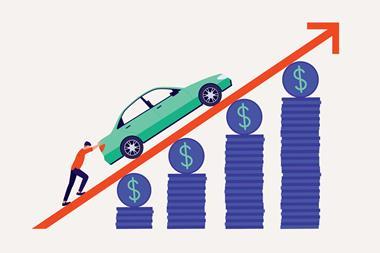The need for motor insurers to rebalance its books will have a significant impact on consumers, says head of UK general insurance
Losses are expected to continue in UK motor insurance in 2023 after the market experienced its “worst performing year in a decade in 2022”, warned law company Ernst and Young (EY).
EY’s latest UK Motor Insurance Results, which were published today (26 June 2023), showed that motor insurers entered the red in 2022 with a recorded net combined ratio (NCR) of 109.5% – compared to 96.6% in a profitable 2021.

The losses last year were largely driven by high inflation – leading to an increase in costs of materials, labour and energy – and low premium costs.
In 2023, EY predicted an NCR of 108.5% in the UK motor insurance market.
The firm also expected premiums to rise by 16% – equating to £74 per policy on average – with a further 11% rise in 2024, which would amount to £59 per policy on average.
EY insurance leader Rodney Bonnard said: “The profitability achieved during the pandemic, when car usage and claims were low, was quickly reversed by the impact of pricing reforms, high inflation, supply chain issues and changing driving habits.
“Last year was an undeniably difficult year for the sector and headwinds look set to continue throughout 2023.
“So, it will be vital that motor insurers continue to manage their costs carefully while also looking for new avenues of growth.”
Consumer impact
This came after Oxbow Partners warned that it was ”undeniably a tough time to be a motor insurer”.
Read: ‘Tough’ 2023 predicted for motor insurance market as high COR forecast
Read: Motor insurance premiums rise as insurers face cost pressures
Explore more motor-related content here or discover other news stories here
It warned that overall profitability was expected to be around 26% lower than pre-Covid levels.
However, the insurance consultancy said there was some improvement for motor insurers compared to 2022.
And according to EY, should insurers make the necessary adjustments to premium prices to keep pace with the rate of inflation, the market should return to a profitable NCR of 97.4% next year.
However, Richard Reed, head of UK general insurance at EY, said that ”the need for the sector to address this and rebalance its books unfortunately means that consumers will face a sharp rise in their premiums”.
“Consumer premium rates have remained far below the level needed to keep pace with inflation and the return to more regular motor activity post-pandemic,” he added.
“2023 will undoubtedly be tough for consumers and insurers alike, but we expect these challenges to ease once inflation falls back.”
Hosted by comedian and actor Tom Allen, 34 Gold, 23 Silver and 22 Bronze awards were handed out across an amazing 34 categories recognising brilliance and innovation right across the breadth of UK general insurance.




















































No comments yet